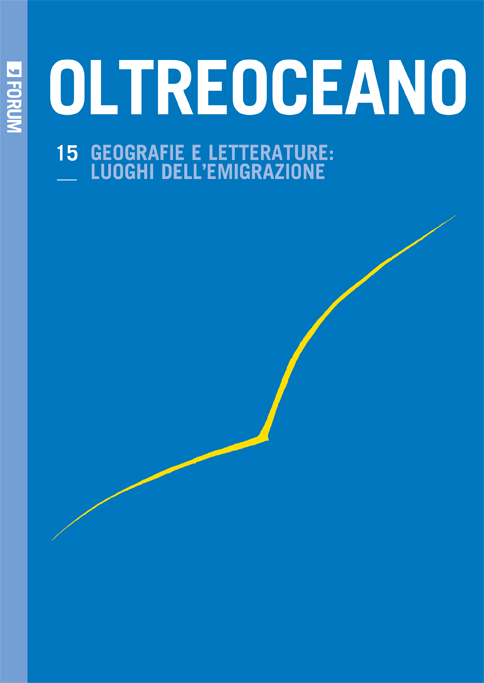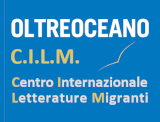Per un approccio geografico ai testi della letteratura migrante
Parole chiave:
letteratura, spazio, emigrazione, Canada, QuébecAbstract
La contaminazione tra strumenti ermeneutici propri della geografia e della letteratura, alla base di una ‘svolta spaziale’ – un cartographical turn – in atto nelle discipline umanistiche, consente di analizzare la realtà da una prospettiva diversa, rinnovando l’approccio epistemologico ai testi letterari. Si tratta di un’analisi particolarmente feconda per la letteratura migrante il cui legame con lo spazio è insito nell’aggettivo che la definisce esprimendo il nomadismo e l’erranza, la mobilità e l’idea di attraversamento delle frontiere, caratteristiche delle opere di questa corrente.
For a geographical approach to the texts of migrant literature
The contamination between hermeneutical tools of geography and literature, at the basis of a ‘cartographical turn’ underway in the humanistic disciplines, has allowed us to analyze reality from a different perspective, renewing the epistemological approach to literary texts. It is a particularly fruitful analysis for migrant literature that bears its inscription with space in the adjective that defines it and which expresses nomadism and wandering, mobility and the idea of crossing boundaries that characterize its works.
Downloads
Riferimenti bibliografici
Aínsa, F. (2006): Del Topos al logos: propuestas de geopoética. Madrid / Frankfurt am Main: Iberoamericana / Vervuert.
Alfano, G. (2010): Paesaggi mappe tracciati. Cinque studi su letteratura e geografia. Napoli: Liguori.
Bhabha, H. K. (1994): The Location of Culture. Londra / New York: Routledge.
Bachelard, G. (1994): La poétique de l’espace. Parigi: PUF.
Bachtin, M. (1979): Le forme del tempo e del cronotopo nel romanzo. Saggi di poetica storica. In M Bachtin, Estetica e romanzo. Un contributo fondamentale alla scienza della letteratura (pp. 231-405). Torino: Einaudi.
Bernd, Z., Imbert, P. & Olivieri-Godet, R. (Eds.) (2019): Espaces et littératures des Amériques: mutation, complémentarité, partage. Québec: PUL (Américana).
Bergé, A. (2010): Sens de l’espace et polygraphie des auteurs migrants. François Cheng et Silvia Baron Supervielle. In S. Bainbrigge, J. Charnley & C. Verdier (Eds.), Francographies. Identité et altérité dans les espaces francophones européens (pp. 317-334). New York: Peter Lang.
Bouvet, R. & El Omari, B. (Eds.) (2003): L’espace en toutes lettres. Québec: Nota Bene.
Bouvet, R. & El Omari, B. (2006): Du parcours nomade à l’errance: une figure de l’entre-deux. In R. Bouvet, A. Carpentier & D. Chartier (Eds.), Nomades, voyageurs, explorateurs, déambulateurs: les modalités du parcours en littérature (pp. 35-50). Parigi: L’Harmattan.
Braidotti, R. (2002): Nuovi soggetti nomadi. Transizioni e identità postnazionaliste. In A. M. Crispino (Ed.). Roma: Sossella.
Brooker, P. & Thacker, A. (Eds.) (2005): Geographies of Modernism Literatures, Cultures, Spaces. Abington (UK): Taylor & Francis.
Brosseau, M. (1996): Des romans-géographes. Parigi: L’Harmattan.
Collot, M. (Ed.) (1996): Les Enjeux du paysage. Bruxelles: Ousia (Recueil).
Collot, M. (Ed.) (2005): Paysage et poésie. Parigi: Corti.
D’Alfonso, A. (1990): Avril ou l’anti-passion. Montréal: VLB.
Deleuze, G. & Guattari, F. (1996): Kafka. Pour une littérature mineure (pp. 29-33). Parigi: Minuit.
Den Toonder, J. (2006): Espace littéraire et voyage identitaire dans l’écriture migrante au Québec. Ying Chen, Dany Laferrière et Régine Robin. In J. Lintvelt, J. den Toonder & J. Morency (Eds.), Romans de la route et voyages identitaires (pp. 129-150). Québec: Nota Bene
Dionisotti, C. (1964): Geografia e storia della letteratura italiana. Torino: Einaudi.
Doyle, L. & Winkhel, L. (Eds.) (2005): Geomodernisms. Race, Modernism, Modernity. Bloomington: Indiana UP.
Dünne, J., Doetsch, H. & Lüdeke, R. (Eds.) (2004): Von Pilgerwegen, Schriftspuren und Blickpunkten. Raumpraktiken in medienhistorischer Perspektive. Würzburg: Königshausen & Neumann.
Garnier, X. & al. (Eds.) (2011): Littératures africaines et territoires. Parigi: Karthala.
Harel, S. (1989): Le Voleur de parcours. Identitéet cosmopolitisme dans la littérature québécoise contemporaine. Longueuil: Le Préambule.
Lahaie, C. (2009): Ces mondes brefs. Pour une géocritique de la nouvelle québécoise contemporaine. Québec: L’instant même.
Laurichesse, J. Y. & Vignes, S. (Eds.) (2018): États des lieux sans les récits français et francophones des années 1980 à nos jours. Parigi: Classiques Garnier.
Lequin, L. (1992): L’épreuve de l’exil et la traversée des frontières. Des voix de femmes. Québec Studies, 14, pp. 31-39.
L’Hérault, P. (1994). Figurations spatiales de l’altéritéchez Antonio D’Alfonso, Gabrielle Roy et Jacques Ferron. Protée. Théories et pratiques sémiotiques, 22, pp. 45-52.
L’Hérault, P. (1997): L’espace immigrant et l’espace amérindien dans le théâtre québécois depuis 1977. Dal¬housie French Studies, 41, pp. 151-167.
L’Hérault, P. (1999): L’interférence des espaces immigrants et de l’espace littéraire québécois. In A. P. De Luca, J.P. Dufiet & A. Ferraro (Eds.), Palinsesti culturali Gli apporti delle immigrazioni alla letteratura del Canada (pp. 49-66. Udine: Forum.
Luzzatto, S. & Pedullà, G. (Eds.) (2010): Atlante della letteratura italiana, I. Dalle origini al Rinascimento. Torino: Einaudi.
Mata Barreiro, C. (Ed.) (2007): Étranger et territorialité. Globe, 10, 1.
Mata Barreira, C. (2012): Hybridité linguistique et culturelle dans les écritures migrantes au Québec: l’identité de la traversée. Nouvelles Études Francophones, 27, 1, pp. 66-84.
Downloads
Pubblicato
Come citare
Fascicolo
Sezione
Licenza
Copyright (c) 2019 Oltreoceano - Rivista sulle migrazioni

Questo lavoro è fornito con la licenza Creative Commons Attribuzione - Non commerciale - Condividi allo stesso modo 4.0 Internazionale.
Gli autori si impegnano a rispettare le seguenti condizioni, che s’intendono accettate al momento della sottomissione per la stampa dei propri contributi.
L’invio di un testo implica che esso sia inedito e non in attesa di essere pubblicato altrove.Gli autori si impegnano a rispettare le seguenti condizioni, che s’intendono accettate al momento della sottomissione per la stampa dei propri contributi.
- Qualora venga accettato, l’autore conferisce all’editore il diritto di pubblicarlo e distribuirlo sia in forma cartacea che nell’edizione elettronica in rete. Gli articoli pubblicati saranno scaricabili e resi disponibili in open access.
- Purché segnali correttamente che la prima pubblicazione è avvenuta sulla rivista «Oltreoceano. Rivista sulle migrazioni», l’autore ha facoltà di: a) riprodurre l’articolo in estratti separati o raccolti in volume; b) pubblicare l’articolo nel proprio sito personale o in quello di corsi di insegnamento purché si tratti di siti di natura non commerciale; c) depositare l’articolo in archivi online di carattere non commerciale, legati all’istituzione di appartenenza o come parte di progetti di diffusione non commerciale e open access dei lavori scientifici.
Non è consentita l’utilizzazione dei contributi da parte di terzi, per fini commerciali o comunque non autorizzati. L’editore declina ogni responsabilità sull’uso non autorizzato del materiale pubblicato sulla rivista.













